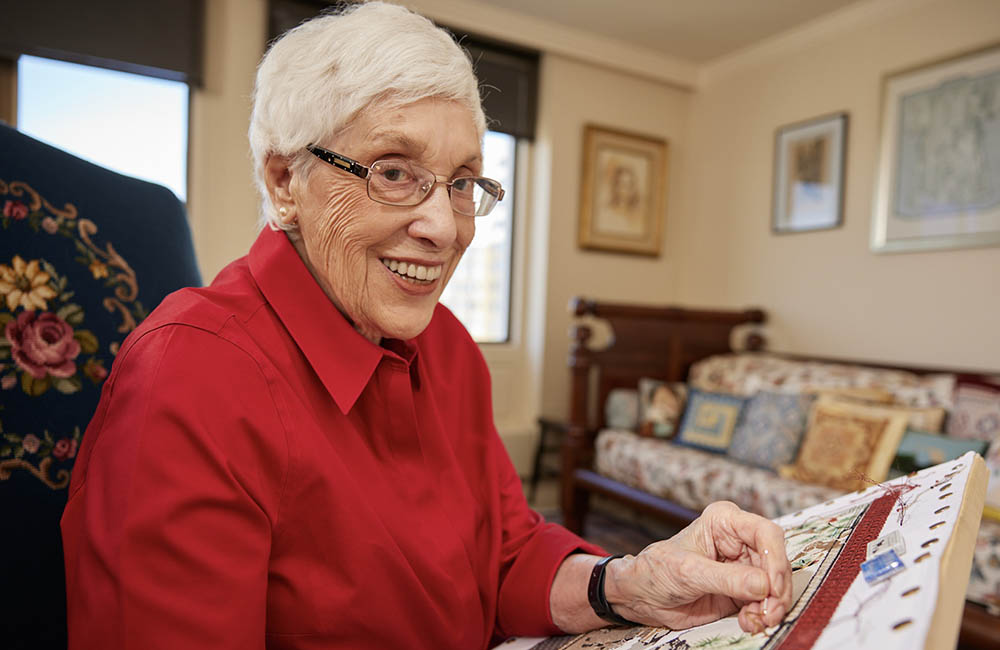News & Resources
How to Talk About Retirement Communities With Aging Parents

If you are reading this article, you probably have an aging parent or loved one who could benefit from the support and wellness programs a retirement community provides. Perhaps the topic has come up indirectly, or maybe it is even something they have been hesitant to discuss.
No matter your loved ones’ level of independence, many older adults wish to remain in their homes as they age. However, they could most likely benefit from learning how much they can gain from making a life plan community, also known as a retirement community, their home.
Retirement communities like those offered by Sequoia Living can make access to health and wellness resources easy. But bringing up this subject can be challenging. Here are several tips to help you navigate this important conversation with understanding and empathy.
Preparing for the Discussion
Talking about something as significant as a move or downsizing isn’t something you’ll want to just jump into. You have to be as prepared as possible and schedule the time so there is ample opportunity for discussion, reactions, questions, and setting the next steps. Make an effort to prepare for the conversation so it feels as effortless and straightforward as possible. Start with the following five steps:
- Study up on the topic.
Before you start discussing anything, make sure you do your research first. You’ll want to learn about terminology, different levels of care, and the advantages of certain models over others — as much information as you can get your hands on. Coming to the conversation with a strong understanding of the differences between a 55+ and a CCRC or a life plan community and knowing things like the various types of contracts vs. Fee-for-service should give you an advantage as you show your loved ones they can trust you as a source of information. Building that extra layer of trust will go a long way in helping them to make a decision. You can use this information online as a resource, but you can also contact one of our Bay Area retirement communities for additional. This whole process can seem confusing, but our sales teams are well-versed experts in explaining the details. - Talk to other family members.
Get the rest of your family involved. It’s important to include other close relatives when deciding on such a significant change to your loved one’s lifestyle. Anyone directly impacted by the choice should be involved in the conversation. - Make a list of concerns.
Determine why you are having this conversation with them in the first place. Are they dealing with consistent health challenges? Are daily activities becoming an issue? Have they stopped seeing friends, and you’re concerned about social isolation? Or do you simply want to make sure they have a plan for the future so they (and you) can have some peace of mind? Whatever the case may be, come prepared to express your concerns openly and honestly. - Having the conversation
The key is to keep it light and simple, especially in the beginning. Discover how Katherine, a devoted daughter and “Sandwich Generation” professional, navigated her mother’s move from Texas to a Sequoia Living Bay Area retirement community. Here are some things you’ll want to keep in mind:
-
- Show empathy.
If you think having this conversation is tough, imagine how tough it is to make the decision. It’s not easy by any means. Nobody likes to face the thought of aging and needing assistance. To take it even further, moving out of the home you raised your children in can be equally difficult to come to terms with. Try to be compassionate and understanding. Ask questions about your loved one’s current quality of life and what they see for themselves and the future. Allow them to come to the decision with you, and they will be more open to it.
- Show empathy.
-
- Take time to listen.
There will likely be a lot of back-and-forth in these discussions, especially as you present all the information you have gathered. It is important to listen to their responses, especially their fears, worries, and concerns, and to keep these in mind as you work together to determine the best solution.
- Take time to listen.
-
- Talk face to face.
Whether you can get together in person or not, there is plenty of technology available that makes face-to-face chats more practical than ever before. Connecting over the internet through Zoom, FaceTime, or Google Meet has never been easier.
- Talk face to face.
-
- Plan the next steps.
Always plan for the next steps at the end of each conversation, even if it’s just “We need to talk more about this.” There will be many of these chats before a decision is made, and keeping the momentum going will be important, so identify specific actions, be it scheduling a follow-up conversation, booking a visit, attending an event, requesting information, talking to a financial planner, etc.
- Plan the next steps.
5. Plan the next steps.
Always plan for the next steps at the end of each conversation, even if it’s just “We need to talk more about this.” There will be many of these chats before a decision is made, and keeping the momentum going will be important, so identify specific actions, be it scheduling a follow-up conversation, booking a visit, attending an event, requesting information, talking to a financial planner, etc.
The Benefits of a Retirement Community
Once you’ve started the conversation, you’ll want to discuss why a retirement community might be better than their current situation. And there’s more to it than you may think. Some of the most important benefits of a retirement life plan community include:
The security of choosing lifelong care.
Probably the most important and obvious reason to move into a retirement community is the dependability of on-site, lifelong care.
- A team of medical professionals on call 24/7 can significantly impact long-term health and make a big difference in overall well-being.
- Making the move a choice now rather than a necessity later can relieve many people of their anxieties as parents or loved ones get older.
- Less stress on themselves and other family members who may be serving as interim caregivers often leads to more happiness across the board.
Less worry about home maintenance.
One of the most exciting things for new residents living in a retirement community is the freedom from housekeeping and yard care.
- Having all of the day-to-day home maintenance handled by a team of professionals takes a lot of stress off older adults.
- Less worry about home maintenance means your parents or loved ones spend more time enjoying what they want to do with their day.
Find out how Craig’s move unlocked a fuller life with support, friendships, and the freedom to pursue his passions.
A whole new community of neighbors to meet.
Making friends can always be a tricky thing, but it’s especially true once you get older. While your 30s and 40s are littered with new faces through work, the connections your children make, and life in general, that change as you age.
- Moving into a retirement community allows residents to be around peers who live within close proximity.
- Having quality friendships has been proven to lower the risk of dementia and increase a person’s lifespan by building stronger mental health.
Michael would agree that moving to a retirement community is a great way to expand your circle of friends, “Making new friends when you’re in your 80s may sound a little odd to some people, but here I am, in my 80s, making new friends.”
This conversation can be hard, but it doesn’t have to be.
While there are plenty of resources out there for you to use as you prepare for this discussion, feel free to visit our website for helpful resources and resident stories, preparing for a move and downsizing, fall prevention, legacy and estate planning, or view previously recorded educational webinars.
Beyond that, you can also use us as a reference when it comes time to start comparing your options. If you have any further questions, please schedule a visit or speak to one of our team members. Select a community below.
